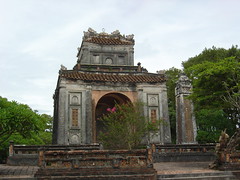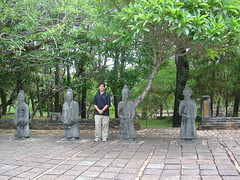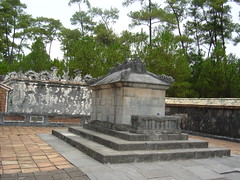Scattered around the countryside around Hue are the tombs and mausoleums of the Nguyen Dynast rulers. Tomb is too light a word to use for these palatial monuments.
Each of these sites is really a summer palace complex that was built for each emperor. Construction would begin as soon as the emperor took the throne and would serve as a retreat from the Imperial City. Each one is different, reflecting the personality and ambition of it's emperor.
The first one we visited was the estate of the Emperor Tu Duc. The estate circles a beautiful lake and has several recreational pavillions surrounding the lake. Tu Duc considered himself a poet and he would sit in the pavillion overlooking the lake while he composed.
The Hoa Khiem Temple shown in the picture doubled as a working palace during his life and included a royal opera theater and lodging for his many concubines. After the the death of an emperor, his many concubines would often stay on as caretakers for the estate.
The actual sarcophogous is within a courtyard up a small hill. The courtyard outside the tomb includes rows of statues of horses, warriors and mandarins. These life size statues are to guard the tomb area.
There was a slave revolt during construction and the design was changed to reflect a new-found humility and modesty on the part of Tu Duc. He still had time for 50 course meals and dozens of concubines.
Unlike western tombs, the Tu Duc Mausoleum is open air and exposed to the elements. Our guide told us that the actual bodies of the emperors were buried in secret locations to avoid grave robbers.
The lake and gardens including a beautiful wooded area were magnificent but very hot. We went through two bottles of water each on the brief hour tour we took of the grounds. Fortunately there were several concession stands set up just for that need.



No comments:
Post a Comment